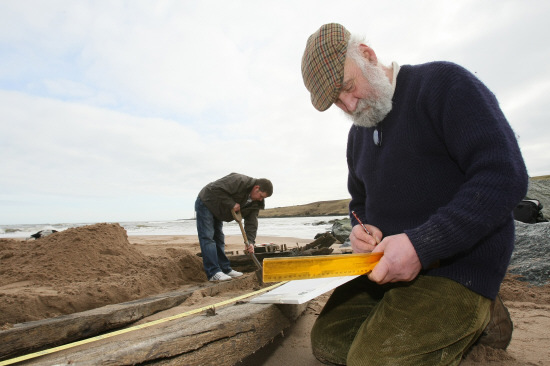The mystery surrounding a shipwreck site in Montrose is continuing to weave its spell after more locals came forward with their own theories about its origin.
Marine archaeologists believe the wreck to be a wide-bottomed 18th century cargo vessel, but haven’t been able to spend much time on site due to unfavourable tides and shifting sands.
Some locals have disputed this theory, arguing that it could also be a wooden shooting target used by Spitfires in the second world war.
However, those claims are now being questioned after other residents came forward to argue that the shape of the wreck all but rules out the “gun target” claims.
Carnoustie man Robert Whyte grew up in Montrose and was familiar with the targets that were constructed in the harbour at Arbuthnott’s shipyard during the war years.
He not only disputes the possibility that the wreck is one of these targets, but also argues that the specially constructed vessels were used for naval gunnery practice and not aerial bombardment.
He said, “The targets were solid and had a keel on them. I don’t think the wreck is a target because this is a hollow-hulled boat and the targets were not. They had solid hulls.
“If ships fired at them and they were hollow-hulled they would have sunk immediately. They had solid hulls so that they would stay afloat.
“This hull is not one of the targets, but there is one lying buried somewhere else in the Montrose sands.”
Mr Whyte, who is a former police officer and fisherman, added that a target did come to grief at Montrose, which may explain the confusion.
“An admiralty tug by the name of Bandit was towing one of these targets out to Scapa Flow for navy ships to use as target practice,” he said.
“When it was towing one of these targets they were attacked by German aircraft. The Bandit didn’t sink and was brought back into the harbour.
“But the target came free (during the attack) and the hull landed on the south side of the river estuary.
“It wasn’t retrieved, so there is a target out there somewhere — but it would have had a solid keel,” Mr Whyte continued.
He also added that local Spitfires did not use the targets for aerial shooting practice. Instead they carried out manoeuvres over Lunan Bay so their gunfire did not panic local residents.
Fellow local John Aitken, who has been examining the wreck with archaeologist Dr Colin Martin, has also disputed the shooting target theory.
He has unearthed a photo that shows one of the targets being constructed in Montrose.
And he argues that the shape of these vessels is completely different to the timbers that have been unearthed at the wreck site.
